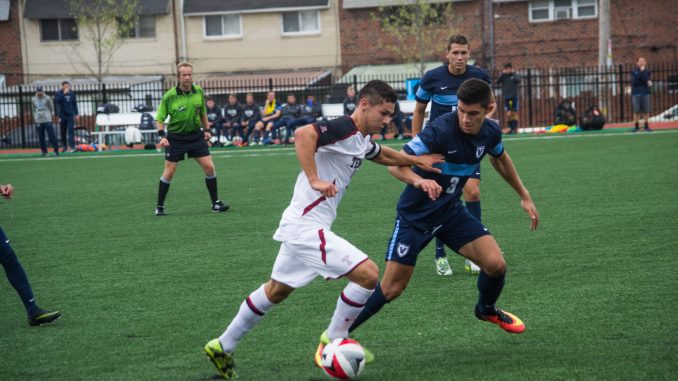
Before every game, the Owls’ backline is sure to reiterate the same plan for the game: keep the opponent from scoring a goal.
“We say it before every game,” senior defender Stefan Mueller said. “It’s great if we can score a goal, but most important is that we don’t give up a goal because if we don’t give up a goal, we can’t lose.”
So far, Temple’s defense has been sticking to its objective. The Owls (8-3-1, 1-1-1) have allowed seven goals in 12 games, averaging 0.58 goals against per match.
The Owls’ defense, along with redshirt-junior goalkeeper Alex Cagle, has recorded shutouts in the past four games and eight total for the season.
The usual starters on defense for the Owls are Mueller, seniors Carlos Moros Gracia and Matt Mahoney, redshirt-junior Mark Grasela and junior midfielder Brendon Creed. The five players have shared a lot of experiences and have worked well together in the past.
“We’ve all played together for a couple years now,” Mueller said. “We don’t really have anyone new on the backline, so we are all comfortable with each other. We know where each other are going to be, so it just comes down to team chemistry and team communication.”
Not only does the backline stay in constant communication, but the players also work closely with Cagle, who will call out commands and observations that give the defense direction.
“He plays a big role,” Mueller said. “I mean, he sees everything on the field. He sees stuff we can’t see, players running in behind, so it’s important for him to keep the communication up.”
The members of the backline emphasized how important communication is when they play together. Some of the understanding they have with each other happens during practice, where the athletes get to know their teammates’ tendencies on the field and where they can look for a pass or extra help when game time comes.
“It’s important to have good communication because we are not four defenders, we are a whole backline,” Moros Gracia said. “I told Creed most of the times I am a player, he’s a player, but when both of us are together, we are three players.”
As a unit, the defense has held its opponents to 99 shots, including 46 shots on target. As a comparison, Temple has 202 shots, 80 of which were on goal.
“Our job really comes down to making sure the opposing team cannot get clear shots on Cagle,” Creed said. “Sometimes, they will make chances throughout the game and then Cagle will, of course, come up with a big save as he usually does, but our job is to limit those chances and make it difficult for the opposing team to get a rhythm.”
While defense isn’t the most glorified position to play in soccer, it has distinct challenges and generally appeals to a certain type of person. The players characterize themselves as tough, aggressive players who will sacrifice their body for a tackle or a stop.
Endurance also plays a big role for the defense. Moros Gracia has played every minute of every game, and Grasela, Mueller and Creed play the majority of the games they start. In addition to the physical toll of the position, the athletes must also be strong mentally and stay focused for the entirety of the game.
“I think in defenders, it’s 50-50 with the mind,” Moros Gracia said. “When you are a forward and you are tired, you can rest, and if you are unable to score, it is OK. But if you are a defender, you have to keep going all the game because you concede a goal, you can lose the game. So it’s important when you are tired also to use your mind to supply the fitness.”
Maura Razanauskas can be reached at maura.razanauskas@temple.edu.


Be the first to comment